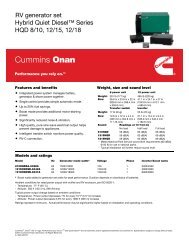Air Brake Manual
Air Brake Manual
Air Brake Manual
You also want an ePaper? Increase the reach of your titles
YUMPU automatically turns print PDFs into web optimized ePapers that Google loves.
Combination Tractor and Trailer with Spring<br />
Parking <strong>Brake</strong>s<br />
The trailer system is supplied by blended tractor air<br />
taken from the primary and secondary circuits<br />
through a two-way check valve as previously<br />
described.<br />
The system is charged by opening the trailer supply<br />
valve (28), allowing air from the tractor to pass<br />
through the tractor protection valve (24) and the<br />
trailer spring parking brake valve (18) directly into the<br />
trailer spring parking brake chambers (15). When air<br />
enters, the pressure protection part of the trailer<br />
spring parking brake valve opens, allowing the air to<br />
fill the trailer reservoirs. The trailer spring brakes will<br />
not release until the reservoir pressure on the trailer<br />
is adequate.<br />
When a brake application is made, blended control<br />
air acts on the relay valve (17), which releases air<br />
from the trailer reservoir to the brake chambers.<br />
In a dual air brake system, if one circuit develops a<br />
leak, the other circuit would be protected from air<br />
pressure loss by the two-way check valve (26).<br />
If the tractor breaks away from the trailer, the control<br />
(service) and supply (emergency) lines will be pulled<br />
apart. The sudden loss of air in the supply (emergency)<br />
line will cause the tractor protection valve to<br />
close, preventing air from escaping out of either<br />
broken connection. The air supply in the tractor is<br />
sealed off and is available to control the tractor<br />
brakes. At the same instant, the sudden loss of air in<br />
the supply (emergency) line causes the trailer spring<br />
parking brake valve to exhaust the air from the<br />
trailer spring parking brake chambers, applying the<br />
trailer brakes. The trailer brakes cannot be released<br />
under these conditions unless the lines are recoupled<br />
and the trailer reservoirs recharged.<br />
If only the supply (emergency) line breaks between<br />
tractor and trailer, the same sequence of events will<br />
occur.<br />
A break or rupture in the control (service) line will<br />
not affect the trailer until a brake application is<br />
made. A loss of pressure in the tractor system will<br />
then result, causing the same emergency brake<br />
application described above. However, the driver<br />
will be able to release the spring parking brakes by<br />
releasing the foot valve, rebuilding air pressure and<br />
opening the trailer supply valve.<br />
To apply the spring parking brakes, the spring<br />
parking brake control valve (27) is closed, causing a<br />
loss of air pressure in the line which applies the<br />
spring parking brakes as described above.<br />
The old and new tractor and trailer systems are fully<br />
interchangeable, whether they are a dual air brake<br />
system or basic air brake system, and whether they<br />
are systems with or without spring parking brakes.<br />
28 26 24<br />
18 15<br />
17<br />
15<br />
58




